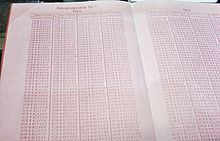Group booklet

The Kenngruppenheft was a secret code book that was used by the U-boats of the Kriegsmarine during the Second World War in connection with short signals to identify their encrypted radio messages . It must not be confused with the identification group book .
The key machine Enigma was primarily used to keep the radio communication between the commander of the submarines (BdU) and the German submarines sunk in the Atlantic and Mediterranean allied ships and convoys secret in the Second World War . from February 1, 1942, it was the Enigma-M4 , also known as the "key M". In addition, secret code documents such as short signal booklet and weather short key were used to further increase the security of the encryption and also to reduce the length of the radio messages and thus reduce the risk of allied radio direction finding (“ Huff-Duff ”) detecting and locating the submarines . To identify short-signal radio messages, they were given an identification group that was taken from a table in the secret identification group booklet.
The group booklet consists of three sections, the "Allocation List", "Part A" and "Part B". In the allocation list, each individual key network, for example “Triton” , “Niobe”, “Thetis”, “Hydra”, “Neptune” or “Aegir”, was assigned a specific number range for the different days. These numbers could be found in the second part of the identification group booklet, Part A. The numbers were listed in a table in three adjacent columns, then the identification groups available for selection as trigrams (three letters) and finally the associated secret motto keys as tetragrams (four letters). The encryptor selected an identification group from the number range assigned to him, such as DDJ, and read the associated key phrase, in the example of the table in the picture this would be ABCK. Then he set the rollers of his key machine by hand to this spell key and encrypted the plain text . The ciphertext generated in this way with a prefixed identification group was broadcast as Morse code and recorded by the recipient. He looked at the first three letters, in the example DDJ, and looked for them in his identical identification group booklet. This contained in the third part, part B, all identification groups in alphabetical order and their number. With their help he was able to read the corresponding four-digit key phrase in Part A and thus decipher the ciphertext .
In the course of the war there were several different editions of the group booklet. The picture shows the identification group booklet No. 7 captured by an American prize squad from U 505 on June 4, 1944 (two days before D-Day ) .
literature
- Arthur O. Bauer: Radio direction finding as an Allied weapon against German submarines 1939-1945 . Self-published, Diemen Netherlands 1997. ISBN 3-00-002142-6
- Friedrich L. Bauer : Deciphered Secrets. Methods and maxims of cryptology. 3rd, revised and expanded edition. Springer, Berlin et al. 2000, ISBN 3-540-67931-6 .
- Dirk Rijmenants: Enigma Message Procedures Used by the Heer, Luftwaffe and Kriegsmarine . Cryptologia , 34: 4, 2010, pp. 329-339. doi: 10.1080 / 01611194.2010.486257
Web links
- Book cover of the Kennguppenheft No. 8 for the Kurzsignalheft 1944. Retrieved: June 8, 2016.
- Identification group booklet No. 8 for the short signal booklet 1944 scan of an original. Retrieved June 8, 2016.
- Short signals from the German submarines. Explanations on the use of the identification group booklet in the Kriegsmarine (English). Retrieved June 8, 2016.